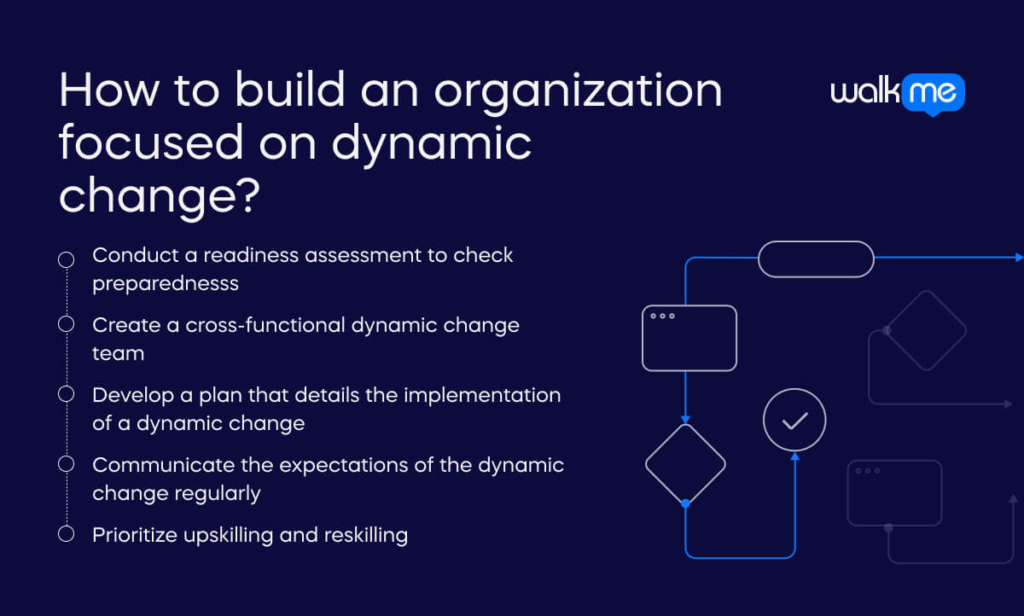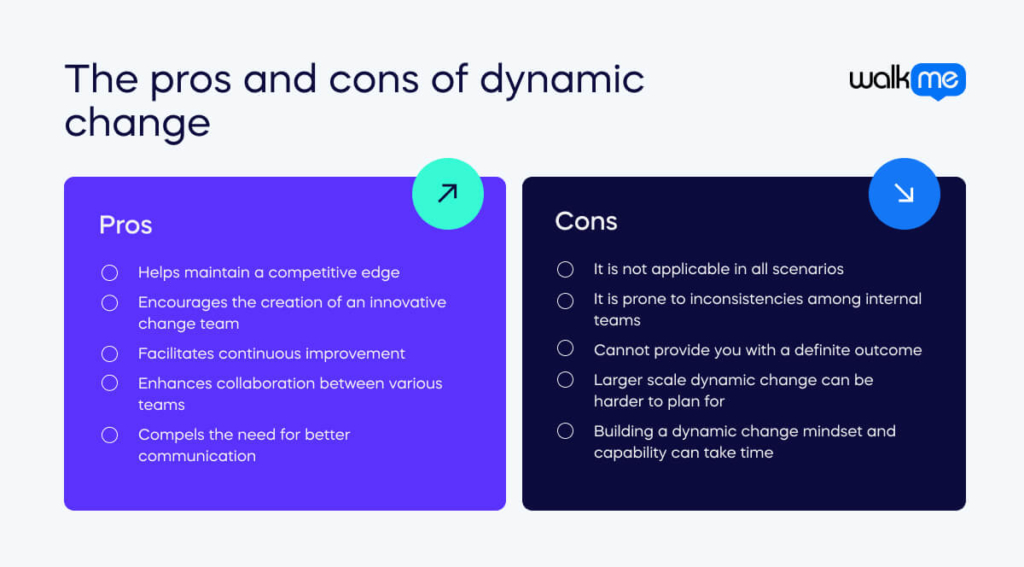As competitive pressures and the pace of transformation accelerate, businesses must continuously deliver better products and superior service just to stay ahead. Yet progress often feels like an uphill battle, especially when initiatives lack strong support across all levels of the organization.
Employee engagement is critical, and this is where dynamic change becomes essential. Unlike static, one-directional strategies, dynamic change encourages organizations to adapt quickly, move beyond silos, and embrace agile frameworks for iterative improvement. These approaches foster collaboration, continuous training, and a culture of accountability that keeps momentum alive.
To succeed, dynamic change also needs to be underpinned by effective change management, ensuring employees understand the purpose behind the shift and remain aligned as the organization evolves.
What is dynamic change?
Dynamic change begins with the organization defining the change and collaboratively crafting a way forward. As the change takes effect, the organization remains responsive, adjusting and innovating within the established framework and jointly developing solutions.
When the change starts to gain traction, increase in scale, and gather momentum, the organization communicates the story of this change throughout the broader organization, fostering a shared understanding and collective experience that simplifies future transitions.
Within agile organizations that adopt a dynamic approach to change, this cycle is not a one-time event but a continuous practice embedded in every facet of its operations.
The process involves establishing the need for change, jointly creating the solution, actively working, listening, adjusting, and sharing the journey. This iterative process exemplifies the organization’s ability to adapt, which is a testament to the robustness of its system.
What is the purpose of dynamic change?
As market dynamics shift, technological advancements emerge, and consumer preferences change, businesses must adapt to remain relevant and competitive.
The essence of dynamic change lies in enhancing the organization’s mobility, agility, and versatility. This process begins with a critical review of existing procedures, questioning the rationale behind current practices and identifying opportunities for improvement.
Leadership must be pivotal in promoting a learning culture to foster a more agile and change-ready workforce. This involves encouraging employees and customers to learn from one another and leveraging these insights to elevate company performance.
By adopting a servant leadership approach, which focuses on empowering and supporting employees to succeed, leaders can create an environment that nurtures positive experiences. These experiences help team members overcome outdated beliefs and embrace change as the new standard.
How to build an organization focused on dynamic change

A company’s survival and ability to outpace its competitors hinge on its capability to adjust, adapt, and overcome challenges. Without these abilities, it risks being overshadowed by the competition or facing obsolescence.
To maintain your competitive edge, here are essential ways to create an organization focused on dynamic change:
Conduct a readiness assessment to check preparedness
Implementing dynamic change within an organization requires a comprehensive approach that begins long before the actual change initiatives are introduced. The first step in this process involves conducting thorough business readiness assessments to gauge the organization’s preparedness for change.
These assessments vary widely, from analyzing the existing company culture and history to evaluating employee readiness and the level of support from potential change sponsors.
Understanding the urgency for change is also critical. Such assessments give the project team a deeper insight into the potential advantages and disadvantages that may emerge during the change process.
It’s equally important to evaluate the strengths of the change management team and the sponsors to ensure they can steer the organization through the upcoming changes.
Create a cross-functional dynamic change team
Leadership is pivotal in navigating change. A leader must comprehensively understand why change is necessary and how it will impact various aspects of the organization, including staff and customers.
This requires forming a fusion team that combines diverse expertise and knowledge to devise the best possible solutions for adapting to the change. This collaborative effort is fundamental to preparing for, implementing, and sustaining the changes, serving as the bedrock upon which the entire change plan is constructed.
Develop a plan that details the implementation of a dynamic change
The creation of a change plan involves detailed planning and strategizing. This plan serves as a roadmap, guiding the leader and the team through the expected and unexpected challenges that will arise during the change process. Preparing for change involves developing a clear plan of action that, with inputs from the team, helps identify and mitigate potential risks.
Once the plan is established, leaders work closely with their teams to outline the steps needed to achieve the set objectives, create timelines with completion dates, and allocate the necessary resources. Understanding what resources are available and how to utilize them best is crucial for both the leader and the team to have a clear picture of what needs to be accomplished, by whom, and within what timeframe.
Communicate the expectations of the dynamic change regularly
Effective communication is paramount throughout the change process. Leaders need to communicate the project’s outcomes, delineate the roles of everyone involved, and assign responsibility for each task.
Leaders also need to foster connections within the team and identify external resources that may contribute to the project, facilitating the exchange of necessary information without requiring the leader to act as a go-between.
This is particularly important in environments where project teams are prevalent, and individuals may simultaneously be involved in multiple projects. Team leaders, who are not necessarily people managers but are skilled in specific areas, benefit from organizational support and development opportunities, ensuring their success in navigating change.
The communication plan must be carefully crafted, analyzing the different audiences involved, the key messages to be conveyed, and the timing and frequency of those messages. Tailoring the communication to meet the specific information needs of frontline employees, supervisors, and executives is vital.
It’s a common misconception among leaders that a few clear communications are sufficient. However, agile leaders recognize the need for continuous and consistent communication to ensure messages are heard and understood, often requiring repetition.
Regularly scheduled meetings are essential for keeping the team updated on project progress, discussing new developments, and maintaining accountability for achieving objectives.
Listening to feedback, especially from those willing to speak up, is invaluable for identifying and managing organizational resistance.
Prioritize upskilling and reskilling
Organizations committed to dynamic change prioritize continuous learning, creating opportunities for employees to upskill, reskill, and reinvent their careers.
This includes empowering managers to support their team members’ skills and career development and fostering a supportive network for a skills-based meritocracy that values ability and contribution over hierarchy or favoritism.
HR technologies like people analytics, talent intelligence, and talent marketplaces can complement traditional human capital management systems.
These AI-based systems are adept at matching skill supply with demand, leading to increased employee retention, improved productivity, innovation, and enhanced cross-functional collaboration.
What are some practical examples of dynamic change?
Understanding practical examples of dynamic change is essential for businesses to navigate the ever-shifting currents of the market, ensuring their agility and resilience in the face of constant flux.
Here are some real-life examples to inspire you to think about using dynamic change within your business:
Commonwealth Bank of Australia
Ian Andrews, Common Bank of Australia’s (CBA) executive general manager, highlighted the importance of the shift from product-focused to customer-centric approaches in financial services when making a dynamic change.
CBA addressed the complexity of implementing multiple dynamic change initiatives by bundling them into unified ‘packages of change’ centered on core themes. This strategy aimed to simplify the process for frontline staff and ensure changes were manageable and aligned with strategic goals.
Governance processes were introduced to maintain thematic consistency and strategic alignment, with narratives from familiar leaders to enhance receptivity.
Each change package covered all distribution channels and included comprehensive transformation strategies, from new technologies to training for frontline staff. Two significant packages were planned to be rolled out annually, with follow-up assessments to ensure successful adoption and provide support where necessary.
The next change package focused on introducing customer-centric initiatives and leveraging analytics and technology improvements from previous efforts. This approach aims to simplify frontline communication, emphasizing new tools and offerings to effectively meet customer needs.
Consistency in communication and implementation strategies across packages was prioritized to make changes feel less disruptive and more familiar, easing adoption.
CBA’s decision-making on what changes to package considered the impact on mindsets and operations across the organization. The successful introduction and adoption depended on direct leadership involvement, highlighting the importance of credible communication and leadership support in facilitating organizational change.
Aegon
Allegra van Hövell-Patrizi, CEO of Aegon the Netherlands, discovered early in her career the importance of aligning teams, adopting a holistic approach, and utilizing a balanced leadership style for successful dynamic change transformation.
She believes effective leadership requires balancing immediate performance and long-term goals, kindness and assertiveness, focusing on individual team members and the team, discipline, and autonomy, and between established processes and innovation.
Her approach begins with a thorough, fact-based assessment of the organization’s current state, including clarity of purpose, culture, team well-being, strategic soundness, client perspectives, competitive landscape, and the robustness of commercial, operational, and financial processes.
Van Hövell-Patrizi then sets out a clear vision for the future, outlining objectives for the next 18 months and three to five years ahead, communicated in simple, engaging language to ensure comprehensibility and repeatability throughout the organization.
This strategy aims to sharpen leadership thinking, foster simplicity and pragmatism, and enhance relatability and effectiveness in guiding the organization from its current state to its desired future.
For instance, under her change leadership at Aegon NL, the definition of new purposes or strategies is accompanied by specific targets related to business outcomes and behaviors, articulated through five straightforward principles that resonate with every employee.
These principles, intentionally crafted to be memorable and incorporating both English and Dutch to reflect Aegon NL’s bilingual environment, include focusing relentlessly on customer satisfaction, avoiding operational errors, fulfilling commitments, resisting unnecessary changes, and striving to positively impact the world.
Van Hövell-Patrizi emphasizes the value of leaders being curious, open to learning from others, and willing to acknowledge their vulnerabilities.
This openness fosters a culture of mutual support and humility, enabling leaders and their teams to work towards a shared goal. It embodies the principle that leadership is not just about directing but about collaborating towards a common purpose.
What are the advantages of dynamic change?
Delving into the pros and cons of dynamic change provides businesses with valuable insights into its potential benefits and challenges, enabling informed decision-making and effective management of organizational evolution.

Embracing dynamic change techniques revolutionizes business transformation, making it more innovative and yielding numerous benefits:
Helps maintain a competitive edge
Dynamic change is not just about responding to changes but proactively anticipating them, enabling businesses to stay ahead of their competitors without compromising the quality of their operations or products.
Encourages the creation of an innovative change team
Creating a high-spirited team of self-driven members is at the heart of successful dynamic change. Such a team is the engine of innovation and change. Building this team requires cultivating an environment that promotes creativity, self-management, and knowledge sharing.
It’s an environment where team members are encouraged to reflect on their experiences, continuously learn, and experiment with new approaches.
Facilitates continuous improvement
One of the other significant advantages of dynamic change is its ability to facilitate continuous improvement in business processes and procedures.
This iterative approach to change allows businesses to remain nimble, quickly adapting to meet the ever-changing demands of their customers and ensuring they remain competitive in their industry.
The flexibility and adaptability offered by dynamic change make it an invaluable tool for businesses looking to thrive in today’s dynamic and uncertain organizational environment, where the ability to adapt and innovate quickly is not just an advantage but a necessity for survival and growth.
By working through various iterations during a project, dynamic change makes estimating the workload and costs for each phase easier, allowing for more accurate budgeting and the ability to accommodate change requests at a reasonable price.
Enhances collaboration between various teams
Moreover, dynamic change enhances communication, transparency, and cross-functional collaboration among project teams and stakeholders.
It means that all individuals understand the project’s goals and work harmoniously to achieve them. This alignment is crucial for the success of any project and reduces the likelihood of failure.
The process inherent in dynamic change, characterized by daily updates, steady communication, frequent testing, and feedback integration, ensures that issues are promptly identified and addressed, keeping the project on track.
Compels the need for better communication
Improved communication is another hallmark of the dynamic change approach. It establishes an effective channel for project teams to convey their needs and expectations to stakeholders and for stakeholders to provide their input and feedback.
This two-way communication streamlines the change process, making it more efficient and effective. The result is a higher quality product or service and a more satisfying experience.
What are the disadvantages of dynamic change?
On the other hand, dynamic change does come with some disadvantages:
It is not applicable in all scenarios
Dynamic change is significant in developing new products, crafting technical solutions, innovating processes, or introducing new operational methodologies.
However, it isn’t universally applicable. In contexts where strict compliance with complex regulations, exhaustive documentation, rigorous testing, and thorough quality assurance are required, the dynamic change approach might fall short.
It is prone to inconsistencies among internal teams
Organizations must secure a unified vision and understanding of the transformation’s value among leadership before diving into dynamic change initiatives. Despite such alignment, challenges arise when companies eager to embrace agile principles like experimentation and empowered teams face inconsistencies.
This occurs as leaders adopt varied agile implementation strategies, or some resist change to preserve the status quo, potentially leading to a fragmented approach.
Cannot provide you with a definite outcome
A distinctive challenge of dynamic change is the uncertainty of the outcome at the start. Solutions and outcomes become more evident with each iteration or might continuously evolve to meet project demands. This iterative nature means business stakeholders frequently manage multiple evolving projects, complicating planning and preparation efforts for impending changes.
Larger scale dynamic change can be harder to plan for
Implementing dynamic change on a small scale within specific organizational pockets can be manageable, allowing for focused resource allocation to ensure success. However, expanding these changes more broadly demands extensive planning considering organizational readiness, resource availability, leadership capacity, and the transformation’s pace.
Such planning for widespread dynamic change can be unpredictable, particularly with iterative changes, posing challenges for employees unaccustomed to this change model. Adjusting to iterative change can strain employee productivity as they acclimate to new processes.
Building a dynamic change mindset and capability can take time
Building dynamic change capabilities across all teams—technical, quality, testing, business stakeholders, and potentially customer advisory teams—is essential. While project teams may become adept with dynamic change techniques over time, business stakeholders might find these methods unfamiliar, necessitating targeted education and capability development.
Without such foundational knowledge, affected business units may not fully endorse or effectively implement the change, hindering the adoption speed and overall transformation success.
Final steps on dynamic change
Dynamic change entails a collaborative, agile process where leadership and team members evaluate their challenges, brainstorm potential solutions, and collectively decide on the best course of action. As solutions are implemented, the team is prepared to adjust, reassess, and pivot as new challenges emerge.
Embracing a dynamic approach to change is advantageous, yet it’s crucial to acknowledge that change comprises both tangible and intangible elements. Tangible aspects might disrupt employees’ routines, whereas intangible aspects affect emotions and morale.
Therefore, it’s essential to support employees through these transitions, ensuring they can adapt to the changes while continuing to fulfill their roles effectively, thus reducing resistance to change.
Leadership plays a vital role in guiding stakeholders to understand that dynamic change, with its iterative feedback loops, is critical in navigating the complexities and uncertainties of their environment. A structured framework like the ADKAR change management model can further facilitate this process.
By helping employees recognize the reasons behind the change, fostering a desire to participate in the change, providing the knowledge and ability to enact change, and reinforcing the change to ensure it sticks, the ADKAR model can be an effective tool in managing the dynamics of change and smoothing the transition for everyone involved.

Frequently Asked Questions
By integrating iterative upskilling and reskilling into workflows, organizations build agility—empowering employees to adapt, innovate, and sustain ongoing change.
Dynamic change relies on collective problem-solving. Breaking down silos through fusion teams fosters shared accountability and faster adaptation.
Conduct readiness assessments before launching dynamic initiatives to gauge preparedness, identify resource gaps, and align sponsors and teams.
Reignite engagement by sharing progress narratives, celebrating quick wins, and adjusting based on team feedback—to maintain trust and initiative velocity.

